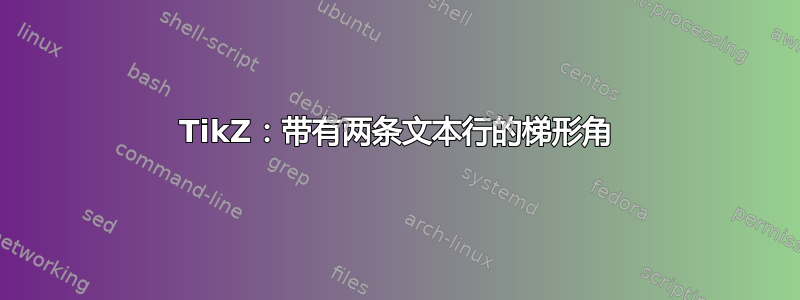
我如何获得相同角度的梯形节点一行和两行文字?当我写两行文字时,总是会产生不同的角度,如下图所示。
梅威瑟:
\documentclass[tikz, margin=3mm]{standalone}
\usetikzlibrary{arrows.meta,shapes}
\begin{document}
\begin{tikzpicture}[node distance = 1.5cm]
% Styles
\tikzstyle{start} = [rectangle, rounded corners, text width=3cm, minimum height=1cm, draw=black, text centered]
\tikzstyle{process} = [rectangle, text width=3cm, minimum height=1cm, draw=black, text centered]
\tikzstyle{input} = [trapezium, trapezium left angle=70, trapezium right angle=110, text width=2.8cm, minimum height=1cm, text centered, trapezium stretches=true, draw=black]
\tikzstyle{arrow} = [thick,->,>=latex]
% Nodes
\node (start) [start] {Start};
\node (P1) [process,below of=start] {Step 1};
\node (I1) [input,left of=P1, xshift=-3.0cm] {Input one: two lines long};
\node (P2) [process,below of=P1] {Step 2};
\node (I2) [input,left of=P2, xshift=-3.0cm] {Input two};
\node (P3) [process,below of=P2] {Step 3};
\node (I3) [input,left of=P3, xshift=-3.0cm] {Input three: two lines long};
\node (stop) [start,below of=P3] {Stop};
% Arrows
\draw [arrow] (start) -- (P1);
\draw [arrow] (I1) -- (P1);
\draw [arrow] (P1) -- (P2);
\draw [arrow] (I2) -- (P2);
\draw [arrow] (P2) -- (P3);
\draw [arrow] (I3) -- (P3);
\draw [arrow] (P3) -- (stop);
\end{tikzpicture}
\end{document}
答案1
当您增加梯形的高度时,这会修改形状,因为它会强制高度,而它已经由另一个参数确定,因此,如果您想增加高度,您可以使用属性inner sep,可以是xsep或ysep..,在代码中的注释中我指出哪些参数会导致修改。
结果:
梅威瑟:
\documentclass[tikz, margin=3mm]{standalone}
\usetikzlibrary{arrows.meta,shapes.geometric,calc}
\begin{document}
\begin{tikzpicture}[node distance = 1.5cm]
% Styles (Its good practice to write like this, you could activate or deactivate options, add comments and avoid put information that goes off the screen like thislike...
\tikzstyle{start} = [
rectangle,
rounded corners,
text width=3cm,
minimum height=1cm,
draw=black,
% dashed,
text centered
]
\tikzstyle{process} = [
rectangle,
text width=3cm,
minimum height=1cm,
draw=black,
text centered
]
\tikzstyle{input} = [ % It's a matter of tuning...
trapezium,
trapezium left angle=70,
trapezium right angle=110,
text width=3cm,
% inner sep=2pt, % Separation between textbox and shape box horizontal and vertical
% inner xsep=5pt, % Idem but only horizontal.
inner ysep=5pt, % Idem but only vertical
minimum width=4.4cm, % it must be the length of the largest trapezoid.
% minimum height=1cm, % It causes the variation of trapezium angles.. use inner sep instead...
% trapezium stretches=true, % It also generate variation of trapezium angles...
text centered,
draw=black
]
\tikzstyle{arrow} = [
thick,
->,
>=latex
]
% Nodes
\node (start) [start] {Start};
\node (P1) [process,below of=start] {Step 1};
\node (I1) [input,left of=P1, xshift=-3.0cm] {Input one: two lines long};
\node (P2) [process,below of=P1] {Step 2};
\node (I2) [input,left of=P2, xshift=-3.0cm] {Input two:};
\node (P3) [process,below of=P2] {Step 3};
\node (I3) [input,left of=P3, xshift=-3.0cm] {Input three: three lines long to get another };
\node (stop) [start,below of=P3] {Stop};
% Arrows
\draw [arrow] (start) -- (P1);
\draw [arrow] (I1) -- (P1);
\draw [arrow] (P1) -- (P2);
\draw [arrow] (I2) -- (P2);
\draw [arrow] (P2) -- (P3);
\draw [arrow] (I3) -- (P3);
\draw [arrow] (P3) -- (stop);
% For inspection:
\draw[dashed, orange,thick] (-6.85,-2.5) -- ++ (70:2);
\draw[dashed, orange,thick] (-6.75,-3.5) -- ++ (70:1.2);
\draw[dashed, orange,thick] (-6.8,-5.5) -- ++ (70:2);
\draw[dashed, orange,thick] (-6.7,-5.55) -- ++ (90:5);
\draw[dashed, orange,thick] (-2.3,-5.55) -- ++ (90:5);
\end{tikzpicture}
\end{document}




